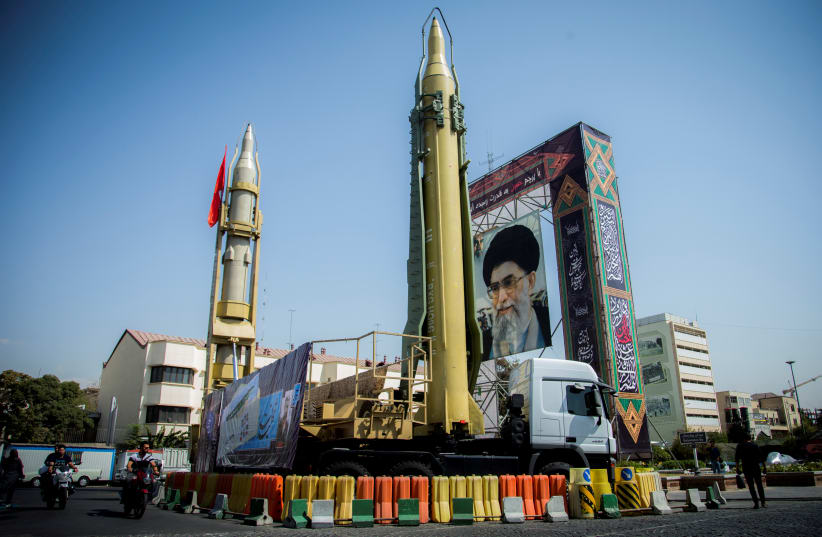Despite its influence and power in the region, Iran’s assets are spread thin and do not involve the ability to confront Israel in a conventional way. Its air and naval forces are no match for Israel’s.But Iran is also constrained by two other problems.Firstly, Iranian President Hassan Rouhani spoke to French President Emmanuel Macron about preserving the Iran nuclear deal on Sunday. US President Donald Trump is looking at a May 12 deadline to recertify the deal, but any retaliation by Iran can ruin any chances of keeping the deal in place. Secondly, Lebanese elections are set to take place on May 6 and Iran’s ally, Hezbollah, is trying to seek more seats in the parliament. Therefore, Iran must be careful because any retaliation could also impact its allies in the larger regional context.MissilesAmos Yadlin and Avner Golov argued in a 2013 paper that an Iranian missile attack constitutes the “main threat” against Israel. In 2018, this could now include the firing of missiles from Syria.But this has been hampered by repeated air strikes on these missiles. For instance, the Hama strike on Sunday allegedly destroyed numerous ground-to-ground missiles.Iran also has drones in Syria. One of them entered Israeli air space in February, provoking a major response against their launch site at the T4 airbase. So Iran’s drone operators in Syria have also suffered losses, degrading their drone retaliation ability.Striking at Jewish and Israeli sites abroadIran can, however, reticulate by striking at Israeli and Jewish sites abroad. Yadlin and Golov point to the “attacks in Buenos Aires in 1992 and 1994 against the Israeli Embassy and the AMIA Jewish Center” as examples of Iran attacking Israel through sites outside the country.Iran’s proxies, such as Hezbollah, have also previously targeted Israelis abroad, such as in the Burgas bombing in 2012 in Bulgaria. There have also been arrests of Hezbollah networks in Cyprus in 2012 and 2015 and an Iranian-sponsored attack on Israeli diplomats in India and Thailand in 2012.Strike at Israeli and Western alliesIran tends to view the US, Israel and US allies, such as Saudi Arabia, as part of the same list of enemies.In Khamenei’s speech on Monday, he alleged that the US has a “plan to provoke some ignorant governments in our own region to confront the Islamic Republic. If these government officials gain some wisdom they won’t confront the Islamic Republic, but if they stand against Iran, they will certainly suffer defeat.” He also called on the US to leave the region.After the Hama explosions on Sunday night, many pro-Syrian regime accounts pointed to the US as the culprit, even producing maps that showed the missiles flying from Tanf on the Jordanian border and claiming that nine missiles had killed 18 Iranian servicemen.It is clear that Iran wanted to tie the US to the strikes. This would indicate that it was paving the way for possible retaliation against US interests as well.Rouhani also told Macron that Trump’s words and threats were violating the Iran deal.Thus, Tehran is paving the way to claim that it is a victim of the US and Israel and giving itself the permission to attack different targets.Harassing the US in SyriaBut the question remains: How can an attack manifest itself?On Sunday, pro-regime forces attacked the US-backed Syrian Democratic Forces near the Euphrates River.Was that a probing attack? Could Iran’s proxies harass US interests in eastern or southern Syria? Might they seek to cause trouble in the Persian Gulf?The Iranian octopus across the Middle East has numerous allies and networks, but no single one of them is very powerful. For instance, in Iraq there are large numbers of militias that support Iran. Together they are a large force, but their ability to do much against US interests there is limited. And any large attacks by them would risk angering the local government that supports them.The same is true in Lebanon. Any major act by Hezbollah brings the risk of its destruction by Lebanon and of its enemies using it as an excuse to encourage its destruction.Tehran’s risksIn Syria, Iran knows that it risks alienating Russia if it stirs up trouble with Israel.Every Iranian base in Syria has essentially led to air strikes in Syria, destabilizing the regime and making it look weak.Russia’s main interest is the survival of the Assad regime. So Iran is undermining the very regime it pretends to support. Russia doesn’t want to be provoked into a showdown with Israel because of the ayatollah’s hubris. Iran has received messages in the past that more bases or provocations or attacks against Israel may result in the Assad regime suffering grievously.How much can Iran risk? How much are its proxies willing to risk?This is the deadly calculation Tehran must make before it can make any move toward retaliation.There is nothing easy about the wholly justified Israeli raids on Iranian targets in Syria. And Iran has capabilities (&dangerous proxies). But the *seeming* ease of Israel repeatedly disrupting &destroying major Iranian investments in Syria must be utterly humiliating in Tehran.
— Dan Shapiro (@DanielBShapiro) April 30, 2018
Iran wants to retaliate against Israel, but how?
Tehran has an array of options at its disposal should it ultimately decide to attack Israel, ranging from missile strikes to hurting its allies.
